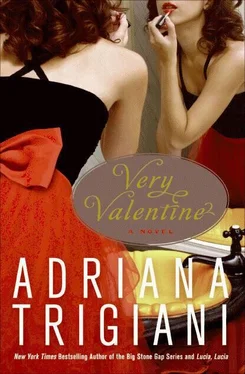I should have sat down with her when I came to work here and had her explain everything, not just the history of our family business, or the mechanics of the craft, but the hard facts, the numbers, the truth about what it takes to keep a small, independent company thriving in this era of mass merchandising and cheap foreign labor. I skirted all that because I was beholden to her for making me her apprentice and allowing me to learn how to make shoes. I was indebted to her, and now I will pay the price.
I would have handled things differently if my mentor wasn’t my grandmother. I never felt I could ask questions because who was I to ask them? But now, I know. I should have asked. I should have asserted myself! I wasted so much time. And there it is, the root of my anger and frustration, so obvious I should have thought of it sooner. I took my time until my thirties to find my calling, and then I waltzed in assuming that the details would take care of themselves. I should have come to work here full-time when I was young and my grandfather was alive. I should have become their apprentice right out of college instead of being sidetracked by Bret and by a career as a teacher, which I was never completely committed to. Then maybe we wouldn’t be in this fix.
I’m a late bloomer, and knowing a little bit about plants the way I do, sometimes late bloomers don’t bloom at all. I may never become the artisan I hope to be because there won’t be a master to teach me, or a place for me to perfect my craft. The Angelini Shoe Company will close, and with it will go my future.
I waded into becoming a shoemaker when I should have jumped in. I’d show up on weekends and help trace patterns, buff leather, dye silk, or cut grommets; but it wasn’t a calling for me at first, it wasn’t as if I was compelled to be a shoemaker. I just wanted an excuse to spend time with Gram.
Then, as these things go, I had an epiphany.
One Saturday morning, when I was still teaching English at Forest Hills High School, I came over to help. I draped a gorgeous piece of embroidered velvet over the cutting table. I picked up a pencil and traced around the edges, marking where the seams of the shoe would eventually go. I had traced the pattern instinctively, without breaking the flow of the line, as though something or someone was guiding me. I had an effortless connection to the task, it came as naturally as breathing. I had found my calling. I knew that was it , no more teaching. I would leave behind that career and my life in Queens, and sadly, Bret, who had his own life plan configured, which didn’t include a struggling artist with student loans, but rather a traditional life, the center of which would be a stay-at-home mother who would raise the children while he took Wall Street by the horns. I didn’t fit in his picture, and he didn’t fit in mine. Love, I decided then, had to wait while I started over.
I pull my sketchbook off the nightstand and wiggle the pencil out of the wire. I flip the pad open and leaf through my sketches of vamps, insoles, heels, and uppers, drawn tentatively at first, then with a stronger hand. I’m getting there, I think as I look at the sketches. I’m getting better, I just need more time.
As I flip through the pages, I reread the notes I’ve scribbled in the margins: try kid leather here? how about elastic there? velvet? Throughout the pages, knowledge imparted by Gram offers me the instructions and facts that I need daily, ideas to revisit and refer to in the day-to-day operation of the shop. Finally, I flip to a clean white page.
I write:
How to Save the Angelini Shoe Company
I am completely overwhelmed. I add:
Since 1903
A hundred and four years have come and gone. The Angelinis were educated and clothed and sheltered with the profits of their shoe shop, a life made and financed by the labor of their own hands. I cannot let the business die, but what does this business mean now, in a world where handcrafted shoes are a luxury? We make custom wedding shoes, in a world where shoes are manufactured and mass-produced in minutes and assembled by cheap labor in factories in corners of the world no one has heard of, or worse, pretend that they don’t exist. Making shoes by hand is an antiquated art form like glass blowing or quilting or canning tomatoes. How do we survive in a contemporary world without losing everything my great-grandfather built? I write:
Sources of Revenue
I stare at the words until my eyes blur. The only people I know with a real knowledge of money and how to gain access to it are Bret and Alfred, two men I’d rather not ask for help. I flip the pad closed, shove the pencil back into the wire, and drop it onto the floor. I turn out the light. I flip over and pull the blanket close. I’ll make this happen , I promise myself. I have to.
BUONITALIA IS AN ITALIAN GROCERY in the Chelsea Market, an old, converted warehouse on Fifteenth Street filled with specialty shops that sell everything from party cakes in the image of Scarlett O’Hara (with antebellum hoop skirts made of frosting) to live lobsters.
The rustic, brightly lit building is a mini-mall of great eating, but nothing tops BuonItalia, as they carry a bounty of all my favorite imports, direct from Italy. You can find everything from jumbo jars of Nutella, a chocolate whip made with hazelnuts (there’s nothing else like it spread on a fresh croissant); Bonomelli’s chamomile flower tea; Molino Spadoni farina (the only kind Gram will put in soup; I’ve been eating it since I was a pup); to big tins of acciughe salate, anchovies straight from Sicily, which we stuff into hot peppers and eat with hot bread.
At the back of the store, a series of open refrigerator bins are filled with fresh, handmade pasta. There’s a special on one of Gram’s favorite noodles, spaghetti al nero seppia, a thin linguine made with the black ink of squid. In the package it looks like licorice whips dusted in cornmeal. I’ll prepare it with fresh lemon, butter, and garlic.
I pick up a package of arugula, some firm white mushrooms, and some roasted red peppers to make a salad. Gram loves Zia Tonia’s dark chocolate curls on vanilla ice cream, her own version of stracciatella gelato, so I pick up a container of that, too. On the way out, I stop at the Wine Vault and buy a bottle of hearty Sicilian Chianti.
As I walk along Greenwich Street, on my way back to the shop, I remember when I was small and my mother wouldn’t allow us to go north of Jane, where the old Meatpacking District merged with the residential West Village. Mom believed that if the speeding meat trucks didn’t kill you, the exposure to the drug peddlers would.
There was some discussion in the early 1980s about Gram and Grandpop selling the shop and getting out of the neighborhood. There were unsolved murders on the docks of the Hudson River and all-night parties in clubs on the West Side Highway named after places you only hear about during a colonoscopy. So many of my grandparents’ contemporaries and neighbors feared the worst, sold their buildings for rock-bottom prices, and left for Long Island, Connecticut, or the Jersey shore. Gram still stays in touch with the Kirshenbaums, who owned a printing press on Jane Street and now live in Connecticut. Friends who hung on until the gentrification of the 1990s fared much better. My grandparents stuck it out, and now Gram will reap the benefits. This strip along the Hudson has become some of the most desired and expensive property on the island of Manhattan.
I remember a more homespun village from my childhood, a working-class neighborhood with a small-town feeling. Gardens weren’t manicured. It was pure luck if you had something green growing on your stoop. Buildings were maintained, not renovated. Redbrick walls were chipped and cracked, beaten by the wind and rain to a dull pink, while concrete steps had chunks missing, like the ears worn away by weather on ancient Greek statues.
Читать дальше












